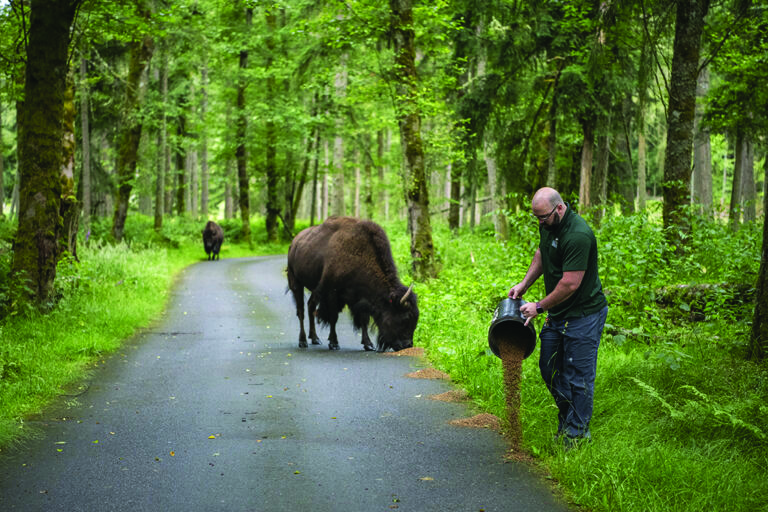In the summer, keepers prepare around 80 pounds of food daily for all the bears, cats, gray wolves, and red foxes. In the winter, that’s cut down to about 20 pounds.
Courtesy Northwest Trek Wildlife Park
The keepers at Northwest Trek Wildlife Park feed nearly 200 animals a day. It takes specific science to prepare proper diets for all the different animals. Each animal’s diet is balanced based on species, age, and health-related issues. We asked the keepers for some of the most fascinating food facts that came to mind.
“The black bears and grizzly bears have quite drastic changes in their diet, depending on the season,” said keeper Carly. “In the summer, they eat a wide variety of fish, fruits, and leafy greens as they prepare for their metabolisms to slow for their winter torpor naps. In the winter, they only eat a few pounds of omnivore chow daily.”
In the summer, keepers prepare around 80 pounds of food daily for all the bears, cats, gray wolves, and red foxes. In the winter, that’s cut down to about 20 pounds.
All year round, Carly says the cougar and the bobcat boys love their fish.
“The cougar prefers salmon, while the bobcats love trout,” said keeper Carly.
She added that keepers offer diluted goat milk as a training reward for all cats- and it’s a huge hit.

Courtesy Northwest Trek Wildlife Park
In the 435-acre Free-Roaming Area, keepers offer 5,000 pounds of chow over two weeks to 113 animals (American bison, moose, Roosevelt elk, black-tailed deer, mountain goats, caribou, bighorn sheep, and a trumpeter swan)
Keeper Wendi says many guests find it interesting how many different types of chows are available for all of the different animals.
“We have a rodent chow, bear chow, insectivore chow, omnivore chow, high-fiber herbivore chow, cricket chow, leafeater chow, and insectivore gel,” said Wendi.
In the 435-acre Free-Roaming Area, keepers offer 5,000 pounds of chow over two weeks to 113 animals (American bison, moose, Roosevelt elk, black-tailed deer, mountain goats, caribou, bighorn sheep, and a trumpeter swan). The chow is a nutritionally balanced, starch and phosphorous-controlled diet for herbivores managed under human care.
In addition, many of the animals eat browse (edible vegetation like twigs, branches, and leaves). The moose can eat up to 60 pounds of browse in one day.
When creating meals, the keepers consider what foods will support an animal’s physical and mental health—to stimulate the same natural behaviors they’d have in the wild. They also get creative in presenting treats and enrichments for the animals to get them curious and engage in those natural behaviors, like finding food.
That means animals are given whole prey in their diets. As a part of their meals, the reptiles, birds, and otters are fed full mice, rabbits, and fish. Carnivores like bears and wolves are occasionally fed whole carcasses.
Comments
Use the comment form below to begin a discussion about this content.
Sign in to comment